Every Frame A Photograph: Shirin Neshat in Conversation
In an early video installation called Soliloquy, 1999, Shirin Neshat, the Iranian-born filmmaker and photographer who has been living in the United States since 1975, casts herself as two women who use architecture as a metaphor through which they show us images of the cultures from which they come: the East and the West, the traditional and the modern, the communal and the individualistic. Shot in Turkey and the United States, Neshat’s soliloquy had a double focus: it was addressed to an art audience as well as to herself. Through a language of structure and form, it visualized the complications of co-inhabiting two radically different cultures. As she herself says, “by the end we find the woman never quite feels at peace in either space.”
In 2003 Neshat made a film called The Last Word in which a woman is summoned to a Kafkaesque interrogation conducted by a man and his group of assistants. Together, they have gathered incriminating evidence to use against her. “Woman, you’ve crossed the line,” the interrogator rants, “you’ve written subversive words, you’ve corrupted human minds, poisoned human souls. Your imagination is that of darkness and darkness is the place of the devil.” What is evident is Neshat’s affinity with the woman (this is literally true to the extent that the actress will speak lines written by Forough Farokhzad, Iran’s most famous female poet and a writer with whom the filmmaker closely identifies). In one way, the accused woman is a surrogate for all artists in Iran, or in any country in which the imagination is threatened by figures of abusive power.
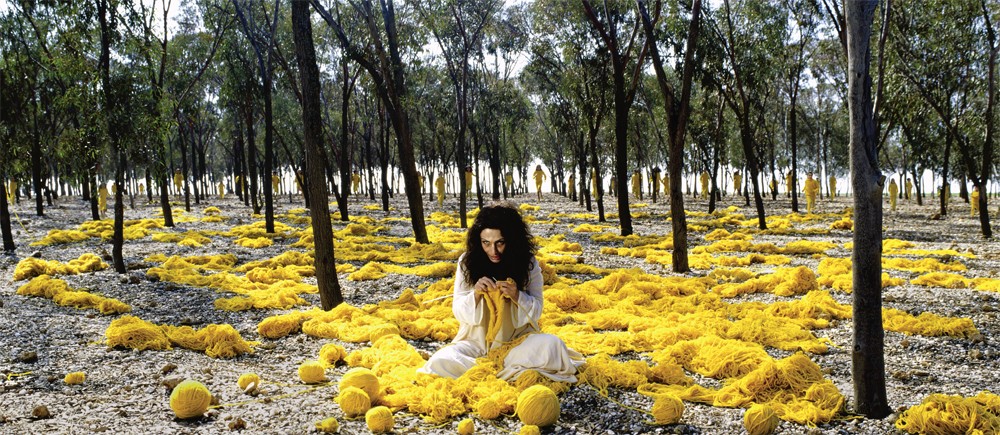
Women Without Men (woman knitting), 2004, C-print, 36 x 92 1/4”, framed, edition of 5 + 1 AP. All images: copyright Shirin Neshat. All images courtesy Gladstone Gallery, New York.

Women Without Men (Untitled 3), 2004, C-print, 28 1/2 x 92”, edition of 5 + 1 AP.
Neshat’s visual world is paradoxically complicated and simple. The simplicity is generated from the look of both her videos and a body of photographs, called Women of Allah, with which her international reputation was launched in the mid-’90s. The work was black and white, dramatic and composed with a rigorous formality.
The complexity was produced by content that refused to submit to an easy reading. In images like Allegiance with Wakefulness, 1994, a gun barrel peeks between the delicate, vulnerable soles of a woman’s feet; in Speechless, 1996, it hangs like a deadly earring on the face of an impassive woman. In Rebellious Silence, 1994, the woman wears a chador and has Farsi poetry scripted across her features. The barrel of a rifle divides her face in two, making it look like a mask. Neshat is herself the model for this last photograph, one image among many that are difficult to situate. Who are these women? Why are the visible parts of their skin covered with love poetry while their hands and feet cradle weapons? Neshat likes their inherent ambiguity. “What can be threatening,” she remarks, “can also be very beautiful.” Writing in The Guardian, she said her photographs were “a peculiar intersection between sexuality, politics and violence.” In the unsettling romance engendered by these images, happiness is, inescapably, a warmed gun.
The titles of her early videos carried a sense of things being on edge–of frenzy, passion, and fervor–or in a situation pulsing with expectation. They were themselves turbulent. But this was only an allusion; the videos were, in fact, understated, made for and shaped by, a culture in which overt declarations were unwelcome and dangerous. Even though she has lived in the United States for over 30 years, she is still making work for the country from which she is exiled.

Women Without Men (Untitled #1), 2004, C-print, 40 1/2 x 65”, edition of 5 + 1 AP.
In The Last Word the woman suffers in silence the prolonged threats of her interrogator but then responds in a way that dumbfounds him. She speaks a poem, written by Forough Farrokhzad, the poet who died in a car accident in 1967 and whose writing and lifestyle had been condemned in Iran. The poem addresses a situation where things seem hopeless, where “law’s black kerchief” has “blindfolded the childlike eyes of her love”; it is a time when she feels her life is nothing more than “the tick tock of a wall clock.” In that dark moment, she discovers the absolute need “to love madly” and to translate that emotion into the resistant language of art and beauty. The woman’s utterance allows her to walk away from her interrogation, and her defiance, her insistence on “grasping the skirt of obstinacy” embodies Neshat’s hopeful belief in the liberating power of the imagination. The poet here is sister to the singer in Turbulent. As Neshat says in the following interview, she has “the power of someone who is able to transcend all the rules and all the conformities and operate on a level that is much more primal. That’s where art belongs.”
Shirin Neshat has shown her photographs, video installations and films in galleries and film festivals all over the world. She has had over 60 one-person exhibitions. Turbulent won the First International Prize at the 48th Venice Biennale in 1999; she won the Infinity Award for Visual Art from the International Center of Photography in 2002 and was an honoree at the First Annual Risk Takers in the Arts Celebration awarded by the Sundance Institute in New York in 2003. In 2006 she was given the Dorothy and Lillian Gish Prize.
Shirin Neshat was interviewed by Border Crossings in her New York studio in June 2008.

Untitled, 1996, RC print and ink, 47 7/8 x 33 3/4”, edition of 10 + 1 AP.
Border Crossings: Do you want to talk a bit about how you were raised in Iran?
Shirin Neshat: I was raised in an upper middle-class family in a rather religious town called Qazvin. My mother was an average housewife who was quite wise but not very educated. My father was the opposite. Although he was a doctor and a farmer, I would consider him an intellectual. He had a passion for literature and world travel and a mind that was much bigger than where he worked and operated. It was the beginning of the period when people were starting to leave Iran and see the world. My father travelled to Europe, Japan and Singapore. He became a kind of heroic figure for me. Even though we lived in a small town, he had the ability to think about the world. The other thing that was unusual about him was that he believed his children should become educated, not only the sons but the girls as well. That was really unusual. My two older sisters, who did become educated, ended up getting married and immediately abandoned their studies. I was the only girl who followed her dreams, so at the end of his life my father was very emotional about the fact that what I became had something to do with the education I had received. The other dramatic thing in my life is that I grew up at the time of the Islamic Revolution. A lot of my close friends became activists, and just as they did that, I left. Then the Revolution happened. This separation was very traumatic for me because I had felt pretty comfortable in my home and situation, and so in the beginning I had a very difficult time adjusting to life in the United States.
In Iran didn’t you go to Catholic schools?
My father had this obsession with his children being exposed to a Western education, and he felt that the small town where we grew up was too provincial. So he put every one of us in an Italian Catholic school, my brothers included. But I didn’t last very long. It was a boarding school and I found it more like a prison. I had a very bad reaction, so I left.

Rebellious Silence, 1994, RC print and ink, 46 5/8 x 31 1/8”.
But then when you were in California you went to a Dominican college?
That was my choice. When I came to California, my sister quickly left, and so at the age of 17, I was by myself. It was devastating to find myself completely cut off from my family. When I graduated from high school I didn’t know what to do, so I had to find schools for myself. It was a total coincidence that this college in the north of California accepted me. At the time it was too hard to get accepted in better schools, like Berkeley, where I went later.
Did you speak English at this time?
I tell my son that when I came to high school I didn’t speak any English at all. I have no idea how they allowed me to graduate but they did.
Was art important in your house? You said literature was, but what about pictorial art?
Not at all. That is another ironic thing. I had never been exposed to art. There was no museum in Iran, at least when I grew up. We were not part of the bourgeois elite class in Tehran, where the King and the Queen had developed and nurtured a very sophisticated culture. Unlike my husband, Shoja, who had been exposed to theatre and art, our life was very provincial. Other than miniature paintings and manuscripts, I had never been exposed to any art but the decorative. I knew all along, though, that I wanted to be an artist. I was the designated artist at the school, painting terrible murals on the walls. I had this tendency, but no one in the immediate or remote family was ever artistic; so there was no reason why I should have been. It’s very odd because usually you’re inspired by a family member, or somehow it’s in your blood, but there was none of that in my case.
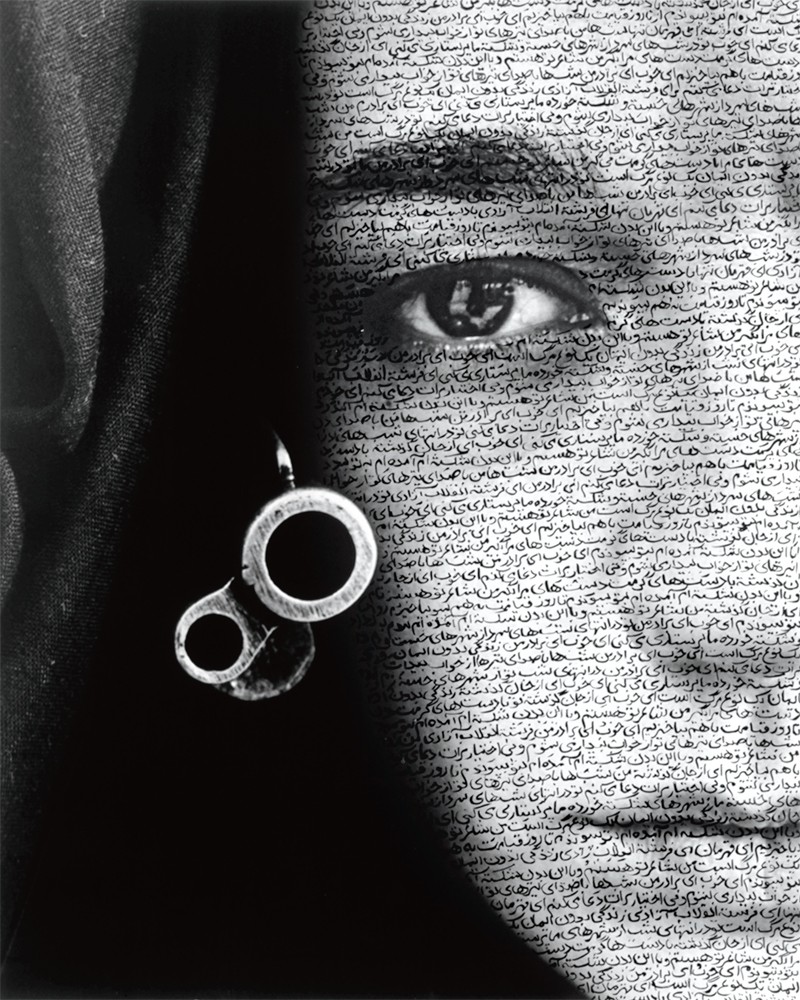
Offered Eyes, 1993, RC print and ink (photo by Plauto), 40 x 60”, edition of 3 + 1 AP.
But if your father was a reader, that must have been an influence on you?
Yes. Iranians read a lot, from the classic poets to more contemporary writers. What was really interesting was that even in high school we were exposed to Western literature. We were reading the existentialists like Sartre and Kafka, and we had writers who were quite heroic to the Iranian people, like Sadeq Hedayat, who became our Kafka. So we had an interesting exposure to very dark minds. At that time there was a lot of anti-Shah sentiment. They were arresting writers, and there were underground books, which became very provocative, and they had something to do with influencing people’s minds. The authorities called it “polluting.” That became very important for the foundation of the Revolution. I had been reading those kinds of things that were always mildly political and artistic.
There is something positively Kafkaesque about The Last Word. The way the woman is treated by the interrogator seems to come entirely out of Kafka.
Well one of the major influences I had, and continue to have to this day, was the poet Forough Farrokhzad, who died when I was only 10 years old.
She died on February 14th, 1967, which in the Western tradition is St. Valentine’s Day, an irony given how beautiful her poetry was.
She is a really heroic figure and, in fact, I have an obsession with the only film she ever made, a short 20-minute-long film called The House is Black. She was revolutionary and extremely subversive in the way she spoke out. At that time, we were a very progressive society and were quickly becoming Westernized, but there were still religious and social taboos about women speaking openly about sexual issues, about the body’s temptation and about love. She was immediately considered a whore, but nevertheless she became a groundbreaking writer. She is one of the figures I became very close to—not just me, but a whole generation of younger artists and writers as well.
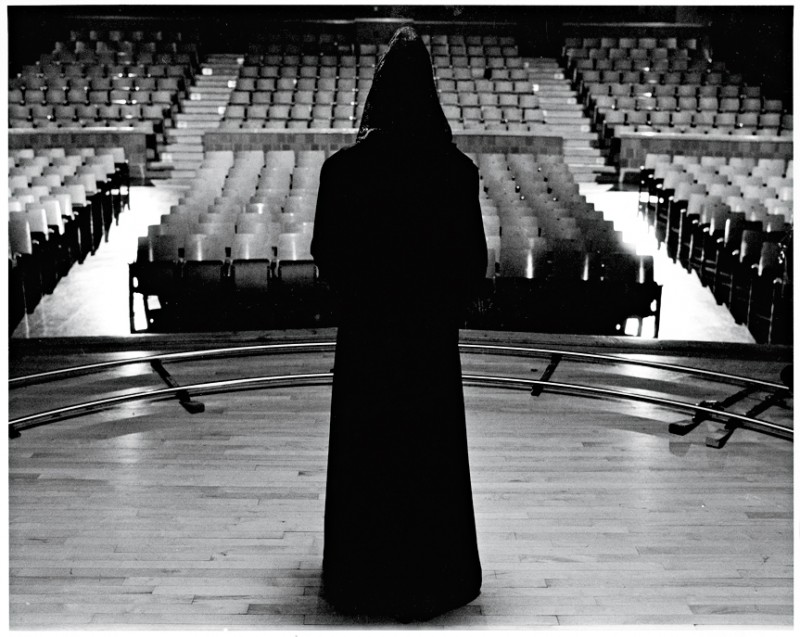
Turbulent, 1998, production still, video/sound installation: black and white, 16 mm film transferred to laserdisc, duration: 10 min.
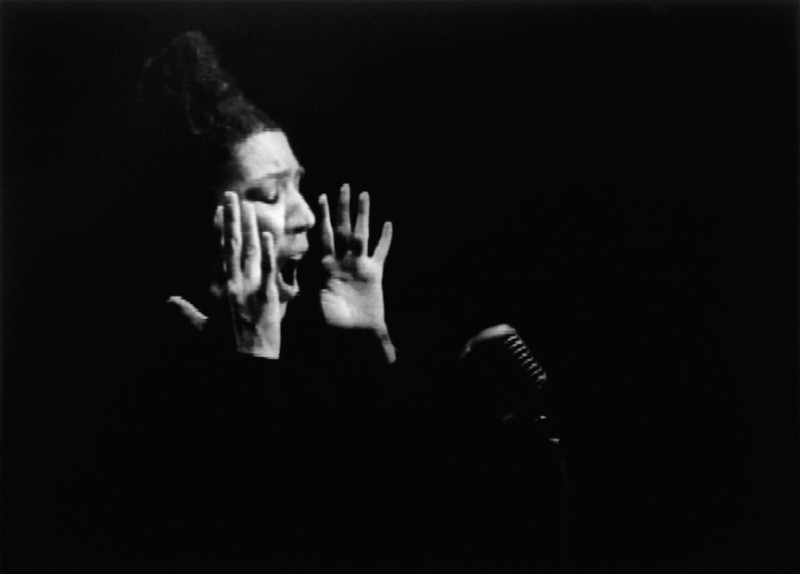
Turbulent, 1998, production still, video/sound installation: black and white, 16 mm film transferred to laserdisc, duration: 10 min.
Would you gravitate towards Farrokhzad more than Rumi because she’s a woman and a contemporary poet?
Absolutely, as opposed to Shoja, who is well read in the classics. My tendency was for more contemporary, darker, sadder and more melancholic writing. I always had an attraction to those kinds of writers, but I was so young it was never pronounced. It was always in the back of my subconscious.
There is one thing that fascinates me about The Last Word. The woman suffers this brutal interrogation and the accompanying threats in silence, and suddenly she recites that beautiful poem. There is a WH Auden line that says, “poetry makes nothing happen,” which is a lament for the ineffectiveness of art as a social agent. Your film seems to argue that by reciting her poem the woman finds liberation and is able to literally walk out of the oppressive situation in which she finds herself. Are you prepared to argue that poetry is a vehicle for social change?

Untitled (Turbulent series), 1998, black and white photograph, 11 x 14”, edition of 10 + 1 AP.

Turbulent, 1998, production still, video/sound installation: black and white, 16 mm film transferred to laserdisc, duration: 10 min.
It wasn’t just poetry, it was people’s imagination. I meant the polarity of the rhetoric and the banality of the world represented by this man of theocracy, of government, of power, this moral judge. She represented the world of the imagination and the creative mind that could be poetry. This was a personal experience, but I didn’t want it to be autobiographical. I wanted it to be about anyone whose creative imagination poses a threat to the world of banality and authority. So there is this dynamic between what she represents—which is timeless and universal and powerful—and what he represents. Still, he is smart enough to detect the subversive nature of the creative imagination that could provoke others, which is very much the case in Iran. Artists, writers and journalists are always being arrested and put in jail because, even though their work can be abstract, these people understand the nature of the threat that it poses. This is our environment because we have a history of great literature. We have learned to speak metaphorically and subversively because of all the censorship, the dictatorships, and the catastrophic governments we have had. Even though it’s not so upfront, people understand what is being said. This is a great asset in Iran. So my own work, even though I live in the United States, tends to have a very sharp knife but in a quiet way. This shows in Iranian poetry, in filmmaking and in art, over and over again, where you have to read between the lines. For me, it was a head-to-head confrontation between a creative person and an interrogator who represents this other paradigm.
He and all the young men who bring him what they regard as incriminating documents are literally struck dumb by her articulation. There is a way in which their world is silenced by the imagination.

Sililoquy Series (Arched Doorway), 2000, colour photograph 60 1/4 x 44 1/4”, framed, edition of 5 + 2 AP.
This was similar to what I tried to do in Turbulent. The male figure is a conformist who does what he’s supposed to do, whether it’s being a preacher, a singer or, in this case, an interrogator. He has a good command of his rhetoric, but she has the power to put him under her spell. Many people have compared this idea to the legend of the storyteller the king wants to kill but who survives by coming up with stories that keep the king entertained. It is very Kafkaesque, very exaggerated and, if anything, almost surrealistic. It’s the paradoxical idea of confronting not just the masculine and the feminine, but also the power of the imagination, the power of someone who is able to transcend all the rules and all conformities and operate on a level that is much more primal. That’s where art belongs.
What you say about the need for subtlety is interesting because in all countries that have had oppressive regimes—I think of the Soviet Union and any number of its satellites—you couldn’t come out and say something directly; it had to be coded or couched in indirect language. Was that also a necessary way for Iranian art to develop because the direct statement could be damaging, if not fatal?
I’m sometimes criticized for saying that, in general, there is an advantage when you have to operate within a certain boundary. I’m not defending censorship, but I think that in societies where there are boundaries in terms of your form of expression, you tend to think deeply within the economy of the situation about how you can say the most with the least, how you can find content and meaning within a poverty of possibilities. There is an incredible challenge in that, and I think Iranian people have really learned from it. There is another thing: poetic language is inherently part of Iranian culture because Iranians deal with the world in a poetic language. We have an ability to use the idea of metaphor, where we say something but we mean something else. Just using the garden as an example of symbolism is telling. On the one hand, a garden could have resonance in a spiritual way in that it represents the idea of paradise, heaven and transcendence to another world. But politically it also means a place of freedom and democracy. There are numerous, endless metaphors. So when someone says you are from the same garden, we understand that to mean that you are from the same political place. When you live in societies where there is such oppressive regulation, you tend to get very creative in how to be expressive and in how to go around the rules. I actually think The Last Word is the most directly critical work I’ve made, and you can see that it is still quite conceptual. On the surface you create situations where the censorship could almost win, but underneath you find that it’s got a very sharp knife. I think you see this in today’s literature, in the films that are produced in Iran. In my work, it is always very relevant.
The idea of the garden is very interesting in Tooba, the film you shot in Mexico about a woman in a tree. Is the myth of the woman transformed into a tree part of that notion of liberation?
This myth of Tooba is taken from the Koran, so it’s not something I fabricated. Actually, Tooba is a sacred tree in Paradise, and as far as I know nowhere in the Koran is it directly mentioned that it is feminine. But it’s commonly known to be the only feminine religious mythology. The writer I have been working with, Shahrnush Parsipur, also refers to Tooba. It is a common Iranian name, but it is a symbol that comes from the Koran. I was particularly interested in religious and popular cultural references. I have to add that some of my work tends to become more poetic and other of it gets more political. So this piece, especially after September 11, had political ramifications. But for me the garden and the tree obviously represented something sacred, a refuge, a sanctuary, a place of safety, a kind of paradise. It was a place where you could run away from all this terrible energy that you saw in those people in black who were just running towards something. Then you had this circle of people, obviously with some kind of power, either religious or government, who seemed to be anticipating something, or who were programming us for something. So it was the relationship between those three parties—the garden which included the tree of Tooba, the people and the circle of men—that I very carefully constructed and crafted. The tree in the garden was a place that I would consider a kind of sanctuary, an oasis. Sadly, the minute the people of power contact the garden, the spirit is lifted and the magic is taken away by the violence they bring. I made it immediately after September 11, and it was a piece that everyone was expecting to be more directly political. But it became more of a poetic gesture. Some people didn’t quite understand in the west, but it was shown in Iran and I was told that people there understood the meaning of the work very quickly.

Soliloquy Series (Modern Building), 2000, cibachrome print, 48 x 60”, edition of 5 + 2 AP.
I’m interested in that tri-partite structure you use. It happens in Passage, too, with the young girl, the circle of women digging, and the advancing crowd of men carrying the coffin. There’s a moment in the film when all three come together. When you storyboard, do you always work within those kinds of structures?
Yes, you have things running parallel, and at some point they all converge. It’s very interesting that you mention Passage because it, Tooba and perhaps Rapture are three films made under the same principle. Even though they had political undertones, they were more overtly interested in poetic expression and also natural symbolism. In Passage there was this dichotomy between the people (who were very morbid and colourless) and nature—the fire, the water, the air and the land (which were very colourful). This return to nature and the elements goes back to the Zoroastrians. It was something that developed intuitively on my part. I had family members who had died very tragically, my father and my sister’s son, and at the same time I was obsessed with images of people dying in Palestine and in Israel. So it was a personal urge to make a piece that dealt with a funeral, with this procession of death. With Tooba there was also the desperate urge on our part as people where we feel the need for a place to feel safe. So there was universality and timeless overtones that didn’t deal with the specificity of Iranian society and politics. That was how Rapture was organized. So going back to your questio —there was no narrative; it was more like these poetic elements were decided by me. In Passage there are the men and the women in black, the little girl and nature. She was always a bystander, an observer, always in the distance, watching. Some people say it was me doing that. Then in Tooba there was the garden again and the tree with Tooba inside, the men in power and the people running. In both films they eventually converge; they were consciously developed under the same strategy.

Rapture Series (Women with Writing on Hands), 1999, colour photograph ,20 x 24”.
When those elements do come together, it can produce an especially beautiful visual image, like the ring of fire in Passage. Clearly the way things look is a central concern. In Fervor there is a sequence where the camera traces down the faces of the pair looking at one another above the top of the curtain and finally the entire screen goes black. It’s a very effective way of describing the distance between them. It’s also a very conscious shot. I guess I’m asking whether every shot is as carefully worked out in your films?
Yes. Because in my work every single frame is a photograph. It also has to do with the way we storyboard. When you’re using more than one screen, the visual relationship between them has to be carefully decided. Nothing is arbitrary or accidental. I’m a control freak, so that even in the feature film I’ve just finished, which is an hour and a half long, everything is meticulously crafted and orchestrated.
Are you a photographer who is actually making thousands of individual images and putting them together in kinetic form?
I’d say so, and that is a problem when you’re thinking about narrative. You don’t always want to think about perfect images. Sometimes you only want to think about storytelling, and that’s something I’ve had to really learn. I feel I’ve gone back to school.

Untitled (Rapture series—Women Pushing Boat), 1999, gelatin silver print, 44 x 68 1/4”, edition of 5 + 2 AP.
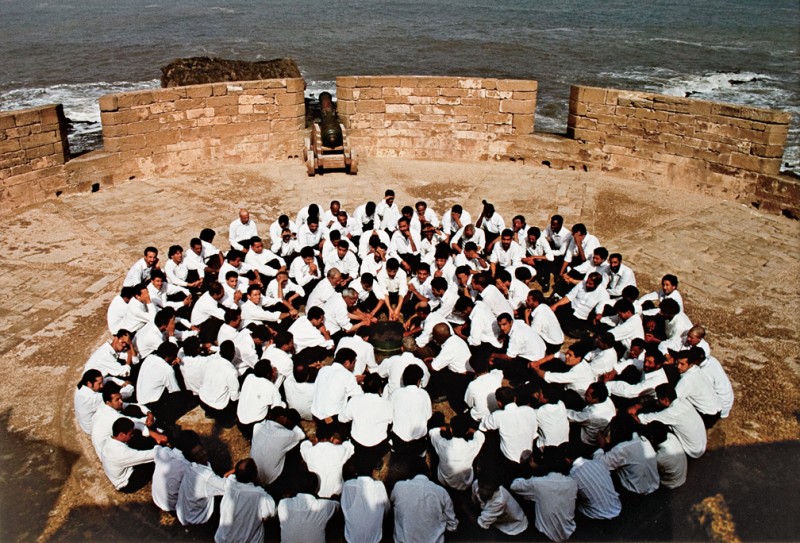
Rapture Series (Men Seated on Circle—ablution), 1999, colour photograph, 40 x 60”, edition of 5 + 2 AP.
Do you always work closely with your Director of Photography and let him know what it is you want?
Yes, Passage and Fervor were shot by the same cinematographer, but Tooba was shot by a very well-known Iranian-French cinematographer, Darius Khondji. Then for the last two or three years, I have been working with Martin Gschlacht, an Austrian who is incredible. I don’t own a still camera, let alone know anything about handling a movie camera. But we do carefully monitor everything.
Is it at Berkeley where you first became interested in photography?
I started as a painter and I wasn’t very good at it. I could either say that my entire education in art was a waste of time or that I was so unprepared intellectually and so immature that I had no way of absorbing anything. I was too busy learning how to stand on my own two feet alone as a young woman. So I didn’t have the capacity to really blossom. It was only about survival, which I think became the groundwork in my own personality that led= to this idea of living in exile, of separation, of being on my own and yet trying to create a relationship with Iran, which eventually became the core of my work. So it was more a question of developing as a human being than as an artist. In that sense my education was boring and not so significant. Then when I came to New York, I found out very quickly that art wasn’t going to be my thing because I had nothing to say. I just wasn’t really very good at it. Photography was never remotely in my mind when I was at Berkeley. It was more drawing and painting.

Fervor Series (Crowd from Back, close-up), 2000, gelatin silver print, 47 x 60”, edition of 5 + 2 AP.

Fervor (Couple at Intersection), 2000, triptych: 3 gelatin silver prints, 49 1/4 x 60” each, edition of 5 + 2 AP.
How did you come to art then?
I worked at an organization called the Storefront for Art and Architecture in New York with my ex-husband. He was the founder, and it was an extraordinary place that was more or less like a laboratory. It was a not-forprofit organization that was mainly dedicated to the practice of art and architecture but that also moved to cultural criticism and philosophy. My ex-husband had one foot in social responsibility and political activism and the other in his concern for the purely aesthetic and design aspect of architecture because that was how he was trained. I worked for the organization for about 10 years. Together we organized exhibitions, books and conferences. I mainly helped him administrate and curate and, as a result, I met interesting people from all realms, including writers, cultural critics and architects. This became my true education in terms of understanding how creative people actually function. What interested me the most was that a lot of their work was based on research; it wasn’t just that they went to a studio, stood in front of a blank wall and said I’ll see what I have to say to the world today. There was also the Storefront’s premise of mixing social responsibility and real life with the aesthetic. When I found my subject, which was the country of Iran and also myself, it was a perfect model for keeping the aesthetic and the personal part of the work in mind while also dealing with the reality of everyday life.
One of the films that clearly addresses that complicated sense is Soliloquy, in which architecture also plays a significant role. In the film you play a woman who is trying to operate in two very different and, in many ways, contradictory cultures. What made you cast yourself in the film?
Well, my sister was supposed to play the part, but at the last minute she changed her mind. It was an experience and something I always wanted to do. I’m not sure how successful it was, but I had an obsession with trying to give a glimpse into the mindset of a person who was simultaneously standing on the threshold of two worlds, West and East, traditional and modern, individualistic versus communal. I became very ambitious and went all the way to Turkey, to this really remote town because the architecture resembled Islamic architecture—it was a difficult place to work—and then here in the World Trade Center. I don’t really like to be in front of the camera, and I don’t like the idea of being at the centre of anything; but I felt that I could convey this double sense. It was the last time I worked in one of my films. I had also posed for photographs. But Soliloquy was an exercise in seeing the same person wear the same thing from two different worlds. The architecture became symbolic of the values of the societies. At the Storefront we were always discussing how architecture was more than just design, that it represented the politics and social strategies of the culture; so I was immersed in this idea of how space and architecture define a society.
You have said that the woman in Soliloquy ultimately doesn’t end up belonging to either of those worlds, that there is a certain sense of dissatisfaction. Is that a feeling that you share with this film character?
I think there is this sense of cultural uncertainly, this lack of equilibrium. Even though I’ve lived here for a very long time, I’m still involved with the Iranian community. I’m very Iranian in terms of my cultural, everyday practice, yet I’m also rooted in European and American culture. There is a part of us that becomes dormant in our lives, and there are times that it become very active. There is this constant psychological shifting that inevitably comes with being an immigrant or with someone who is in a cultural transition. It’s not so easy because you have to constantly change personality according to who you are dealing with and the situation in which you find yourself.

The Last Word, 2003, gelatin silver print, 30 x 16”, edition of 5 + 2 AP.
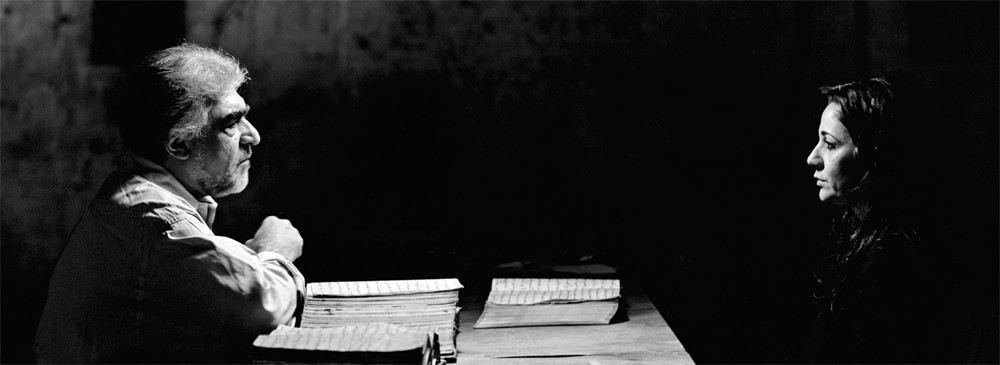
The Last Word, 2003, gelatin silver print, 37 x 95”, edition of 5 + 2 AP.
So is someone who is an immigrant to a country necessarily a chameleon? Do you have to put on the shades of the culture in order to be part of it?
Absolutely, and sometimes that’s not so easy. I have a lot of Iranian people around me, and I have to practice certain mannerisms and codes that come with that culture, ones I don’t have to be aware of with my western friends. The way people deal with one another is not so straightforward. You have to read between the lines of what they are really saying. There is an expression in my language when someone says, “Please eat something,” and you say, “No, I really don’t want any.” But you have to say it 15 times because the person will say “No” the first 10 times, and then you convince them to accept. In the western world, you either want it or you don’t. My mother would always yell at me because I would eat the first time.
One of the areas where difference comes up in reading your work is in Women of Allah. It concerns the sexuality of the images and the use of the eyes as a seduction. When you made them, were you aware that you were walking into territory that could be misunderstood or misread?
I don’t know if it is misunderstood as much as it is a question of different layers. The idea of beauty is a big part of my work. Now beauty could also be sensuality, it could be exotic, it could be all kinds of things. But there’s this juxtaposition between beauty and violence, and I sometimes have to exaggerate one side to make my point about the other. The female body is central to my work because often I deal with the way in which it is used, not only as a taboo subject, but also in the way that men use it to exercise their authority. So the body has political symbolism that goes beyond women’s issues. The female body is such a loaded subject in Islamic culture that it can be approached in many ways. For example, I’m very interested in the power of the woman and the way in which her body becomes a vehicle both in biological and sexual terms. A woman can be very seductive just by having her eyes exposed. I think it is fantastic how telling and how communicative that can be. I’m still blown away by that every time I travel to Muslim cultures. It’s the same with men. They’re not allowed to look at you, and once they make eye contact, even if you’re not drawn to that person sexually, there is something very chilling about it. The forbidden often triggers highly sensual experiences. So for me the recreation is not that the woman is stunningly beautiful. It’s the forbiddenness, the taboo, of the female body that often becomes so poignant and provocative. By creating a wall around women, Muslim societies have made women more desirable.
In Women of Allah, having a gun barrel hanging as the pendant on an earring is as directly articulated a juxtaposition of beauty and violence as one could imagine.
And the gun sometimes is quite beautiful as an object. I’ve had to take a lot of pictures of guns, and the irony is that what can be threatening can also be very beautiful. I played with the veil in the same way; it’s a symbol of repression, but it’s also a symbol of independence and freedom from western ideas that control a lot of the society. So everything has multiple meanings. A martyr is someone who can kill and destroy life, but a martyr is also someone who thinks he’s going to heaven. For me all the elements that I use—the body, the veil, the weapon and the writing—are always about the paradoxical.
Is the writing contemporary Farsi poetry?
Yes.
It raises the question of translation. As a western audience how much can we comprehend? Who are you making the pieces for?
When an artist is making a work, I’m not sure how much they can actually think about the audience. In my case the question of translation is not just about the word, but even the meaning of the work is sometimes difficult to translate. So all kinds of things can get lost in translation. Also, the same work can be lost in translation to the Iranian people who may not be familiar with conceptual art. So the degree of communication is always a dubious question. What I’m saying is the work would be read differently by an Iranian than by a westerner, even if you translated the poetry word by word. An Iranian would understand who is the writer, what is the author’s history, what is the significance of this kind of expression and it’s relevance to the country; whereas the westerner would only understand the word-by-word translation. While this is something I’m aware of, I try to pay attention to the integrity of the work and worry about the translation later.

Untitled (Zarin Series), 2005, C-print, 68 x 59”, 73 3/8 x 64 3/8”, edition of 5 + 2 AP.
Because you work in binaries—tonal as well as thematic ones—your work can also get channelled in ways that don’t encourage a multi-layered reading. It’s often black and white, male and female, spirituality and secularity. These binaries keep coming in. The trouble with binary thinking is that it tends to narrow the reading.
I think it’s just the opposite. The most successful work I’ve done is where it’s completely open to interpretation. It doesn’t try to dictate one way of reading. The worst work I’ve made narrows down to one thing. So for me it has always been very important, whether I’m shooting a photograph or making a video, to construct it in such a way that the viewer will continue thinking about it: what does it really mean, what is she trying to say, who is the evil character and who is the good one? In terms of visual strategies, I don’t use colour because I think colour is very seductive and distracting, whereas I think that black and white is very severe. If I use Turbulent as an example, you could read it as a political and sociological dialogue about how women are absent from the music industry in Iran, but I think it goes far beyond that. The music becomes something more primal and universal, and it raises questions not only about the male and the female but also about who breaks the boundaries and who takes things into their own control as opposed to who conforms. So my goal is not to be reductive and to have an open mind. The viewer is caught between two screens and is forced to edit the film themselves. Because they’re not able to see everything at the same time, they have to decide how to read the story.
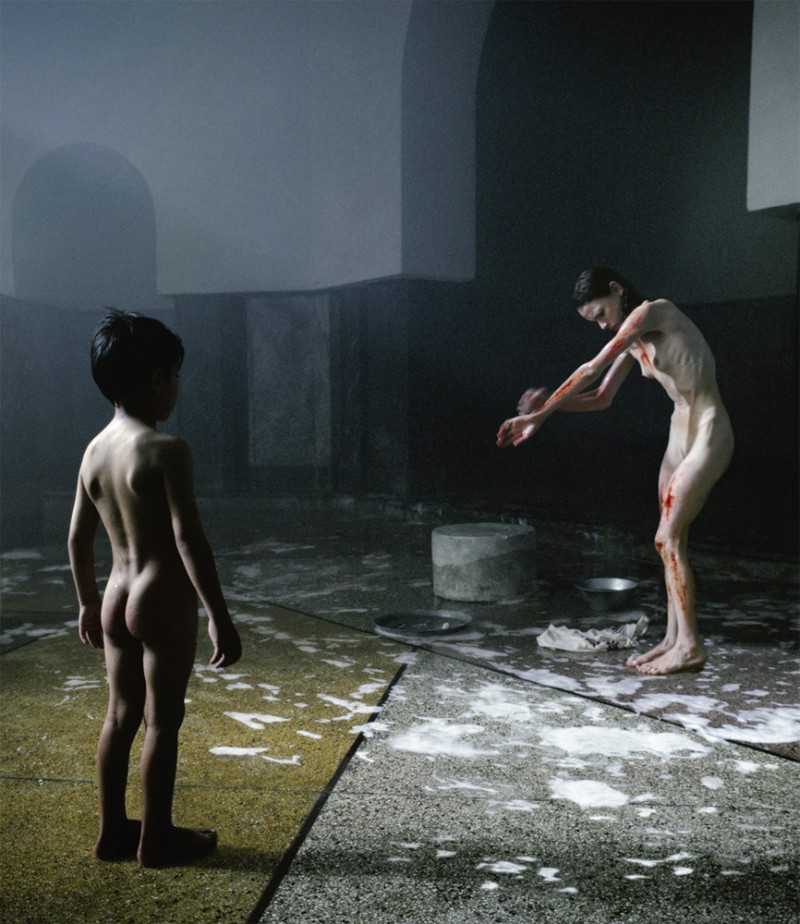
Zarin (Zarin Series), 2005, C-print, 55 x 47 1/2”, edition of 5 + 2 AP.
In Rapture, when the women set out in the boat, you would be happy with a reading that sees their decision as both suicidal and a move towards freedom?
That’s exactly right. I didn’t want to show them falling in the water and dying. It could happen, but they could also be courageous in taking their destiny in their own hands. Then what is the role of the men? Is it that they’re stupid? I just like the ambiguity and the fact that it can be left open for interpretation. My newest feature represents a new way of constructing a narrative, where the audience will have to make sense of it. Women Without Men is the novel by Shahrnush Parsipur, and individual videos that I have made, like Zarin and Munis, are single characters from that novel. But I have re-adapted the novel into a long feature film, so what you actually see are fragments of the film.
In a number of those videos, most dramatically in Possessed, madness is a way out, as is suicide. It’s an escape.
It’s interesting that you mention that because it does seem to be a repeating theme. Parsipur has been institutionalized a number of times, struggling with a bipolar problem. I think her characters resemble my characters. They exist in another kind of world because Shahrnush herself exists in her own world of the imagination. This can seem a romantic thing to say, but sometimes people survive in a state of madness and that becomes contagious. When you live in your own little world, it has its own rules, and when you start breaking the rules, other people want to follow. It’s a fascinating subject. Possessed was like that. Because of her madness, the woman dropped her veil.
Is Zarin’s madness specifically related to the fact that she’s a prostitute?
Zarin is a very fascinating subject because Shahrnush built her character as a kind of prostitute who turns saintly. In the feature film she is eventually saved by the gardener, a kind of angelic figure who makes this analogy between Jesus Christ and Mary Magdalene. In our film, Zarin, who has suffered the most, becomes more spiritual and more sacred, a kind of goddess. The image of her in the hammam (public bath) is a replication of the image of Christ. In the new feature, through her death, which is very beautiful, she becomes a saviour for other women.
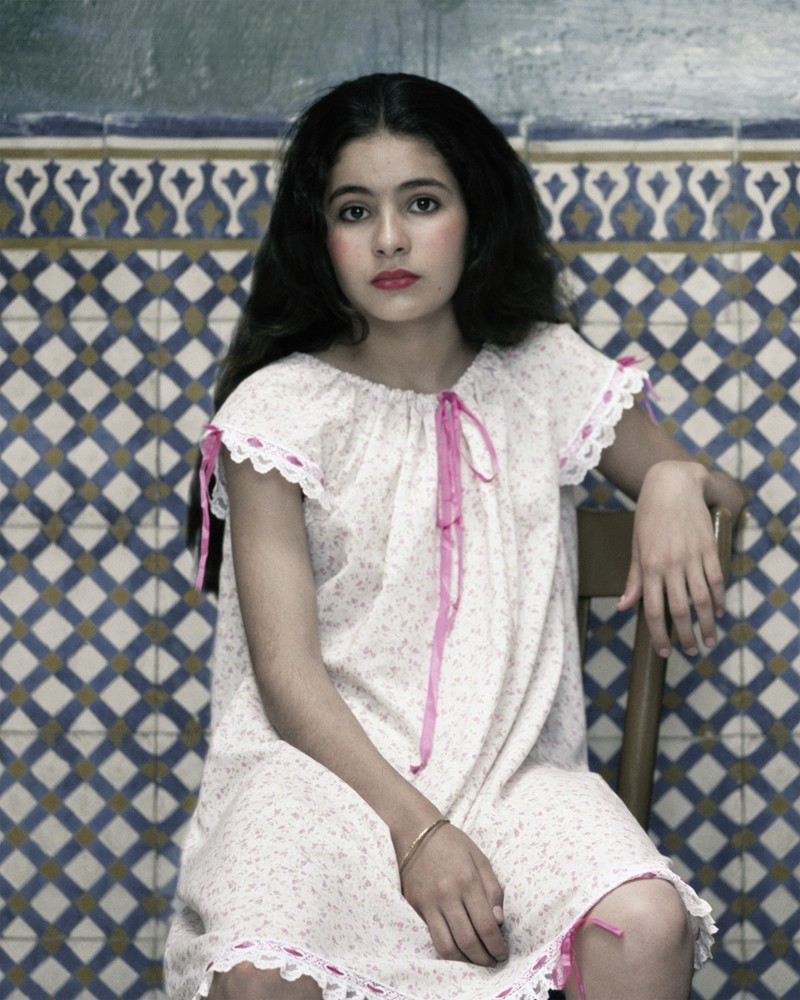
Soroya (Zarin Series), 2005, C-print, 60 x 47 1/2”, edition of 5 + 2 AP.
There is a moment early in Zarin where she’s being touched by the gardener, which I read as the beginning of sexual enjoyment. There are moments in your films where the viewer is confused. In Faezeh when the young woman is assaulted in the forest, you can’t tell whether she is in pain or in a kind of ecstasy. I assume that complicated read is deliberate?
Yes, it is deliberate. The thing with Zarin is that she hated to have sex, and for once someone touched her and it felt good. When she opens her eyes to see who touched her in this way, he is a faceless man. In my mind the gardener is her saviour, but being the first faceless man, he is the reason she runs away from the brothel. This is intentional because in Faezeh’s story she was confronting herself; her worst nightmare is that she might have enjoyed being sexually targeted. The sexual taboo runs very deep and it’s very complex. In both these cases—anorexia and female sexual mutilation— I’m dealing with universal issues. The social stigma is not reduced to Islam and Islamic societies. It concerns any woman who suffers from questions of sexual taboo and the problem of the body, or the psychological problems that come up when you’re not satisfied with who you are, so you mutilate yourself. The Hungarian actress who plays Zarin suffers from this disease. She has gotten much better. But with Faezeh, it was more complicated because she was the good girl who was caught between the moral issues she was confronting. And Zarin, her alter ego, is also in the film. So we have both the good girl and the bad girl. This was not part of the novel, but I took a lot of liberties, and since the film is magic realism, we have numerous scenes where we lose reality and go into magic, dream and Surrealism.

Faezeh & Amir Kahn, 2008, C-print and ink, 88 x 70”, edition of 5 + 2 AP.
Why not state or show things directly?
I think what you’re talking about is the enigma. In the feature-length film we’ve had to discuss how to balance the level of enigma, particularly when you’re dealing with popular culture. This film is not designed for a gallery or a museum but for theatres, where you might lose the audience. It’s always about balancing, and now that I’ve finished the film, I’m asking an editor who doesn’t know my work and who doesn’t know the novel to look at the film objectively to see what might be missing. It’s a question of accessibility. I also want viewers to use their imaginations and not be spoon-fed by the information. I think that would be terribly sad. The enigma should be there, but the degree is really important, and this is something that I constantly battle with. I’m obviously not interested in making easy, realistic art, but at the same time I don’t want to be lost in obscurity and incomprehensibility.
Music is an important component in your films. Does that come out of your cultural background, or is it something you have developed on your own over the years?
I always used to say that, at some point, music took the place of calligraphy in the way that it suggests the picture’s emotionality. I think that the music elevates it above the political or sociological narrative and brings in the individual and human aspect. I have to say that over the years working with Sussan Deyhim, Philip Glass and now Ryuichi Sakamoto, who has scored very beautiful music for Zarin and for the feature, that I’ve learned not just about music, but also about the question of sound, about its minimalism and its economies. It’s not a question of overwhelming the audience with all this emotional back and forth. With simple strategies you can heighten the emotions and the anxieties. So I’m becoming more minimal about the music but more aware of its effect in adding more human aspects of the narrative that could otherwise get lost.

Munis & Revolutionary Man, 2008, C-print and ink, 49 x 90 4/5”, edition of 5 + 2 AP.
In Passage, the Philip Glass score has a special kind of intensity when the women are digging. When you first see them, the dust they generate makes it impossible to see what it is they are actually doing. There is a mystery to their actions. The score seems orchestrated to cover the intensity of all the movements in the film.
At the beginning, some people criticized the music, saying it was too grand, too Hollywood. But over time this music has grown on me. I think it has this melancholic feeling that resonates with the action. I couldn’t have been happier with the music.

Summer 1953 series #3, 2008, silver gelatin print, 40 x 49 3/4”, edition of 5 + 2 AP.
How did the collaboration come about?
Glass has a practice of working with a lot of artists, and he had this concept of commissioning artists to make videos. Atom Egoyan did one, Peter Greenaway, a wonderful Israeli artist, Michal Rovner, myself and Godfrey Reggio, who has continuously worked with Glass. We all made 10-minute films and he set the music for each one. We met before to talk about the theme of our projects, and then he started to imagine the sounds, after which there was an advanced back and forth for a year. He plays live to the films and he is extraordinary.
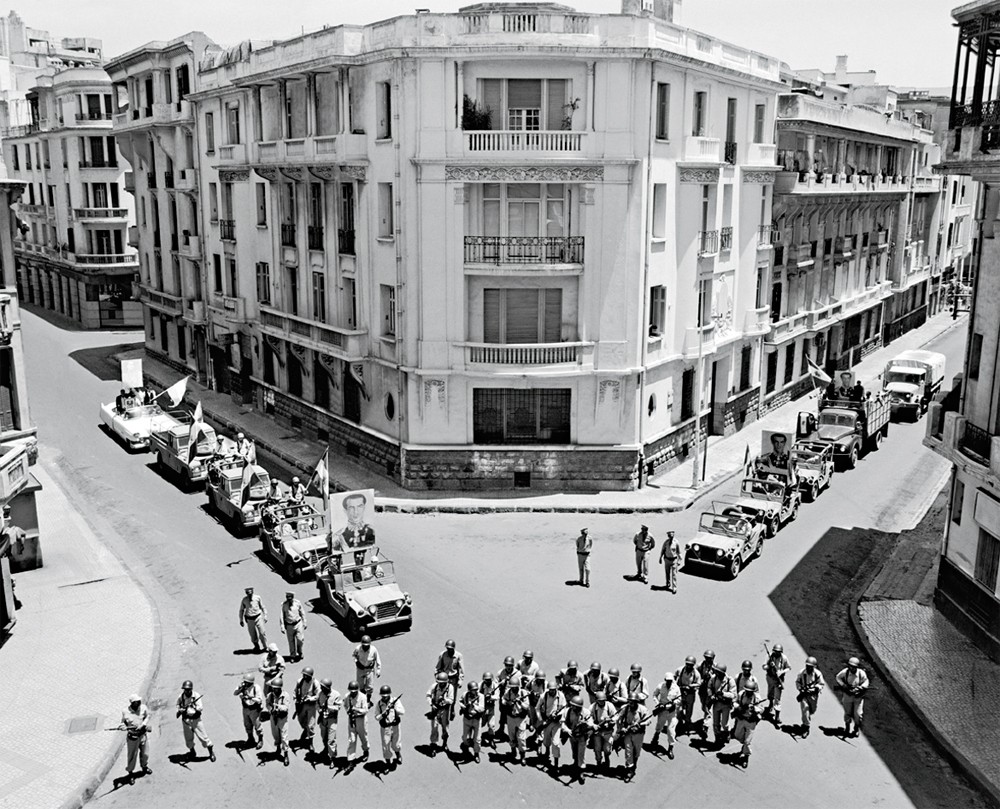
Summer 1953 series #4, 2008, silver gelatin print, 40 x 49 3/4”, edition of 5 + 2 AP.
There is a way that your subject matter and the fact that you’re working with black and white creates a language of its own. There is the scene in Fervor where the man and the woman first meet. The shadow she casts on the ground—and this is shot from an aerial perspective— makes her seem like a beautiful bird. It almost takes you outside what you’re actually seeing.
There is something incredibly powerful about the garment. It has this feeling of void, it has this feeling of ghost, and it is also very provocative and aesthetically appealing. When I made Rapture, the best aesthetic exercise was putting 100 women in black veils by the sea. I remember at the time there were buses going by filled with tourists, and they thought I was filming some kind of ritual. From every side the chador is quite beautiful. It hasn’t anything to do with the faces; it has to do with the simplicity of the garment.

